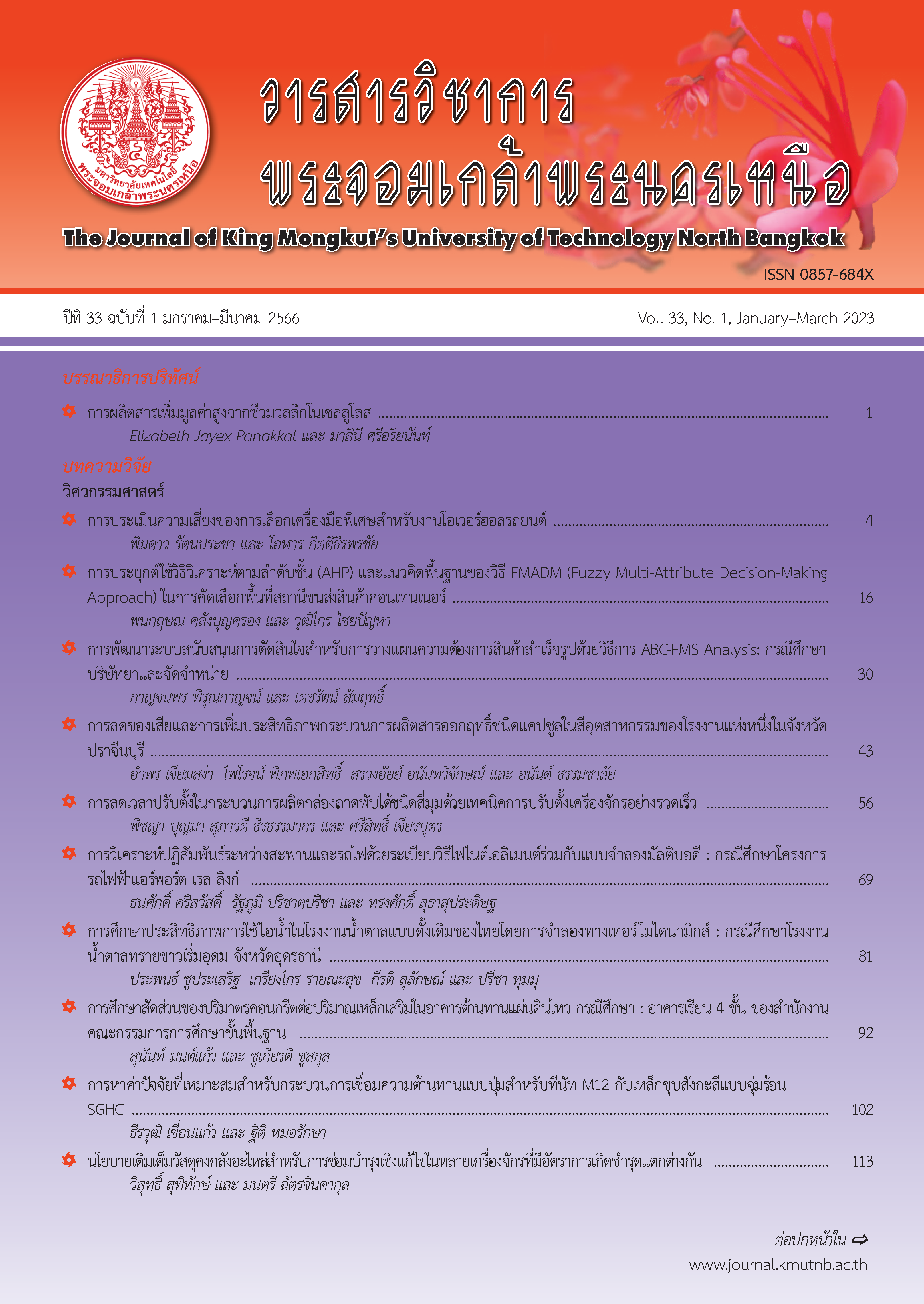การหาสภาวะที่เหมาะสมของกระบวนการผลิตน้ำลูกหว้าเข้มข้นด้วยการระเหยสุญญากาศโดยใช้วิธีการทางพื้นผิวตอบสนอง
Main Article Content
บทคัดย่อ
น้ำลูกหว้ามีปริมาณน้ำสูงซึ่งทำให้อายุการเก็บสั้นและเพิ่มต้นทุนในการขนส่ง งานวิจัยนี้ใช้วิธีการทางพื้นผิวตอบสนอง (Response Surface Methodology; RSM) ตรวจสอบผลของตัวแปรสภาวะในการทำระเหยด้วยเครื่องระเหยสุญญากาศ ได้แก่ อุณหภูมิและเวลา ต่อคุณสมบัติทางเคมีกายภาพของน้ำลูกหว้าเข้มข้น ประเมินคุณภาพของน้ำลูกหว้าเข้มข้นโดยการวิเคราะห์ค่า pH ปริมาณของแข็งที่ละลายได้ ค่าความหนืด ค่าสี Hunter L* a* b* และการทดสอบทางประสาทสัมผัส หารูปแบบความเหมาะสม (Fit) ของตัวแปรอิสระและตัวแปรตอบสนองโดยใช้สมการพหุนามกำลังสอง ผลที่ได้แสดงให้เห็นว่าทั้งอุณหภูมิและเวลาในการทำระเหยส่งผลกระทบอย่างมีนัยสำคัญ (p<0.05) ต่อคุณภาพโดยรวมและการยอมรับของผลิตภัณฑ์ อุณหภูมิในการระเหยที่เพิ่มขึ้นส่งผลให้ค่า pH ลดลง ปริมาณของแข็งที่ละลายได้ทั้งหมดและความหนืดมีค่าเพิ่มขึ้น (p<0.05) เมื่ออุณหภูมิในการทำระเหยเพิ่มขึ้น ค่าความสว่างของสี Hunter L* ได้รับอิทธิพลจากตัวแปรอุณหภูมิของกระบวนการ ส่วนระยะเวลาในการระเหยส่งผลต่อค่าสี Hunter a* และ b* ของน้ำลูกหว้าเข้มข้น ส่วนคะแนนการทดสอบทางประสาทสัมผัสจากผู้ทดสอบชิมพบว่าได้รับอิทธิพลต่อบางคุณลักษณะ สภาวะที่เหมาะสมในกระบวนการผลิตน้ำลูกหว้าเข้มข้นด้วยเครื่องระเหยสุญญากาศ คือปฏิบัติการระเหยที่อุณหภูมิ 83.58 องศาเซลเซียส เป็นเวลา 50 นาที เพื่อให้ได้น้ำลูกหว้าเข้มข้นที่มีคุณภาพเหมาะสม สำหรับการทดสอบความแม่นยำของแบบจำลอง ได้นำค่าที่ได้จากการทดลองเปรียบเทียบกับค่าที่ได้จากการทำนายเพื่อตรวจสอบความถูกต้องของแบบจำลอง พบว่าค่าที่ได้จากการทดลองสอดคล้องกับค่าที่ได้จากการทำนาย นั่นแสดงให้เห็นว่าแบบจำลองมีความเหมาะสมในการนำไปใช้ทำนายคุณภาพผลิตภัณฑ์น้ำลูกหว้าเข้มข้นโดยใช้วิธีการทางพื้นผิวตอบสนองสำหรับหาสภาวะที่เหมาะสมเพื่อให้ได้รับคุณสมบัติทางเคมีกายภาพและคุณภาพทางประสาทสัมผัสที่ดีของผลิตภัณฑ์น้ำลูกหว้าเข้มข้น
Article Details

อนุญาตภายใต้เงื่อนไข Creative Commons Attribution-NonCommercial-NoDerivatives 4.0 International License.
บทความที่ลงตีพิมพ์เป็นข้อคิดเห็นของผู้เขียนเท่านั้น
ผู้เขียนจะต้องเป็นผู้รับผิดชอบต่อผลทางกฎหมายใดๆ ที่อาจเกิดขึ้นจากบทความนั้น
เอกสารอ้างอิง
O. Phuseerit, C. Najan, Y. Pangsri, and S. Rattanasuk, “Effect of yeast isolated from sugarcane juice on quality of jambolan plum (Syzygium cumini) wine,” The Science Journal of Phetchaburi Rajabhat University, vol. 16, no. 1, pp. 35–41, 2019 (in Thai).
R. Patel and T. V. Ramna Rao, “Growth and ripening in black plum [Syzygium cumini (L.) Skeels],” International Journal of Fruit Science, vol. 14, pp. 147–156, 2014.
J. M. Veigas, M. S. Narayan, P. M. Laxman, and B. Neelwarne. “Chemical nature, stability and bioefficacies of anthocyanins from fruit peel of Syzygium cumini Skeels,” Food Chemistry, vol. 105, pp. 619–627, 2007.
R. M. Rastogi and B. N. Mehrotra, Compendium of Indian Medicinal Plants (vol. 1), New Delhi: Publication and Information Directorate, 1990.
A. R. Silva, T. Oludemi, C. Costa, J. Barros, I. Ferreirac, J. Nunes, M. A. Prieto, J. Simal- Gandara, L. Barros, and I. Ferreira, “Mushrooms bio-residues valorisation: Optimisation of ergosterol extraction using response surface methodology,” Food and Bioproducts Processing, vol. 122, pp. 183–192, 2020.
A. Singh and G. S. Kocher, “Standardization of seed and peel infused Syzygium cumini -wine fermentation using response surface methodology,” LWT-Food Science and Technology, vol. 134, 109994, pp. 1–8, 2020.
F. Jafari, K. Movagharnejad, and E. Sadeghi. “Infrared drying effects on the quality of eggplant slices and process optimization using response surface methodology,” Food Chemistry, vol. 333, no. 11, pp. 1–8, 2020.
C. K. Pua, N. S. A. Hamid, C. P. Tan, H. Mirhosseini, R. B. A. Rahman, and G. Rusul, “Optimization of drum drying processing parameters for production of jackfruit (Artocarpus heterophyllus) powder using response surface methodology,” LWT-Food Science and Technology, vol. 43, no. 2, pp. 343–349, 2010.
H. Mirhosseini, C. P. Tan, N. Hamid, and S. Yusof, “Optimization the contents of arabic gum, xanthan and orange oil affecting on turbidity, cloudiness, average particle size, polydispersity index and density in orange beverage emulsion,” Food Hydrocolloids, vol. 22, no. 7, pp. 1212–1223, 2008.
W. C. Lee, S. Yusof, N. Hamid, and B. S. Baharin, “Optimizing conditions of enzymatic clarification of banana juice using response surface methodology,” Journal of Food Engineering, vol. 73, pp. 55–63, 2006.
Z. Pietrasik and E. C. Y. Li-Chan, “Response surface methodology study on the effects of salt, microbial transglutaminase and heating temperature on pork batter gel properties,” Food Research International, vol. 35, pp. 387–396, 2002.
B. Bazaria and P. Kumar, “Compositional changes in functional attributes of vacuum concentrated beetroot juice,” Journal of Food Processing and Preservation, vol. 40, no. 6, pp. 1215–1222, 2016.
A. Chaovanalikit, A. Mingmuang, T. Kijbanluewit, and N. Chondamrongkul, “Effect of processing method on quality of mangosteen juice concentrate,” Journal of Srinakharinwirot University (Journal of Science and Technology, vol. 2, no. 3, pp. 99–107, 2010 (in Thai).
D. C. Montgomery, G. C. Runger, and N. F. Hubele, Engineering Statistics. New Jersey: Wiley, 2001.
P. D. Haaland, Experimental Design in Biotechnology. New York: Marcel Dekker, 1989.
R. Hu, Food Product Design: A Computer Aided Statistical Approach. Pennsylvenia: Technomic Publishing Co., Ltd., 1999.
S. Keshani, A. Luqman Chuah, M. M. Nourouzi, A. R. Russly, and B. Jamilah, “Optimization of concentration process on pomelo fruit juice using response surface methodology (RSM),” International Food Research Journal, vol. 17, pp. 733–742, 2010.
S. Sabanci and F. Icier. “Enhancement of the performance of sour cherry juice concentration process in vacuum evaporator by assisting ohmic heating source,” Food and Bioproducts Processing, vol. 122, pp. 269–279, 2020.
S. Keshani, A. Luqman Chuah, and A. R. Russly, “Effect of temperature and concentration on rheological properties pomelo juice concentrates,” International Food Research Journal, vol. 19, no. 2, pp. 553–562, 2012.
L. Bayindirli, “Density and viscosity of grape juice as a function of concentration and temperature,” Journal of Food Processing and Preservation, vol. 17, no. 2, pp. 147–151, 1993.
A. Ibarz, C. Gonzalez, S. Esplugas, and M. Vicente, “Rheology of clarified fruit Juices. III: Orange juices,” Journal of Food Engineering, vol. 21, pp. 485–494, 1994.
S. Kormin, “The effect of heat processing on triterpene glycosides and antioxidant activity of herbal pegaga (Centella asiatica L. Urban) drink,” M.S. thesis, Faculty of Chemical and Natural Resources Engineering, University Technology Malaysia, Skudai, Malaysia, 2005.
M. V. Martinez and J. R. Whitaker, “The biochemistry and control of enzymatic browning,” Journal of Trends in Food Science and Technology, vol. 6, no. 6, pp. 195–200, 1995.
A. Kırca, M. Özkan, and B. Cemeroglu, “Effects of temperature, solid content and pH on the stability of black carrot anthocyanins,” Food Chemistry, vol. 101, pp. 212-218, 2007.
P. R. Patel and T. V. R. Rao, “Growth and ripening in black plum [Syzygium cumini (L.) Skeels],” International Journal of Fruit Science, vol. 14, pp. 147–156, 2014.
M. Ayyanar and P. Subash-Babu, “Syzygium cumini (L.) Skeels: A review of its phytochemical constituents and traditional uses,” Asian Pacific Journal of Tropical Biomedicine, vol. 2, no. 3, pp. 240–246, 2012.
K. Karseno, E. Wuryatmo, T. Yanto, and R. Setyawati, “Effect of pH and temperature on browning intensity of coconut sugar and its antioxidant activity,” Food Research, vol. 2, no. 1, pp. 32 – 38, 2018.
C. Y. Leong and L. S. Chua, “Optimization of concentrating process using rotary vacuum evaporation for pineapple juice,” Chemical Engineering Transactions, vol. 78, pp. 7–12, 2020.
J. W. Rhim, R. V. Nunes, V. A. Jones, and K. R. Swartzel, “Kinetics of colour change of grape juice generated using linearly increasing temperature,” Journal of Food Science, vol. 54, pp. 776–777, 1989.

